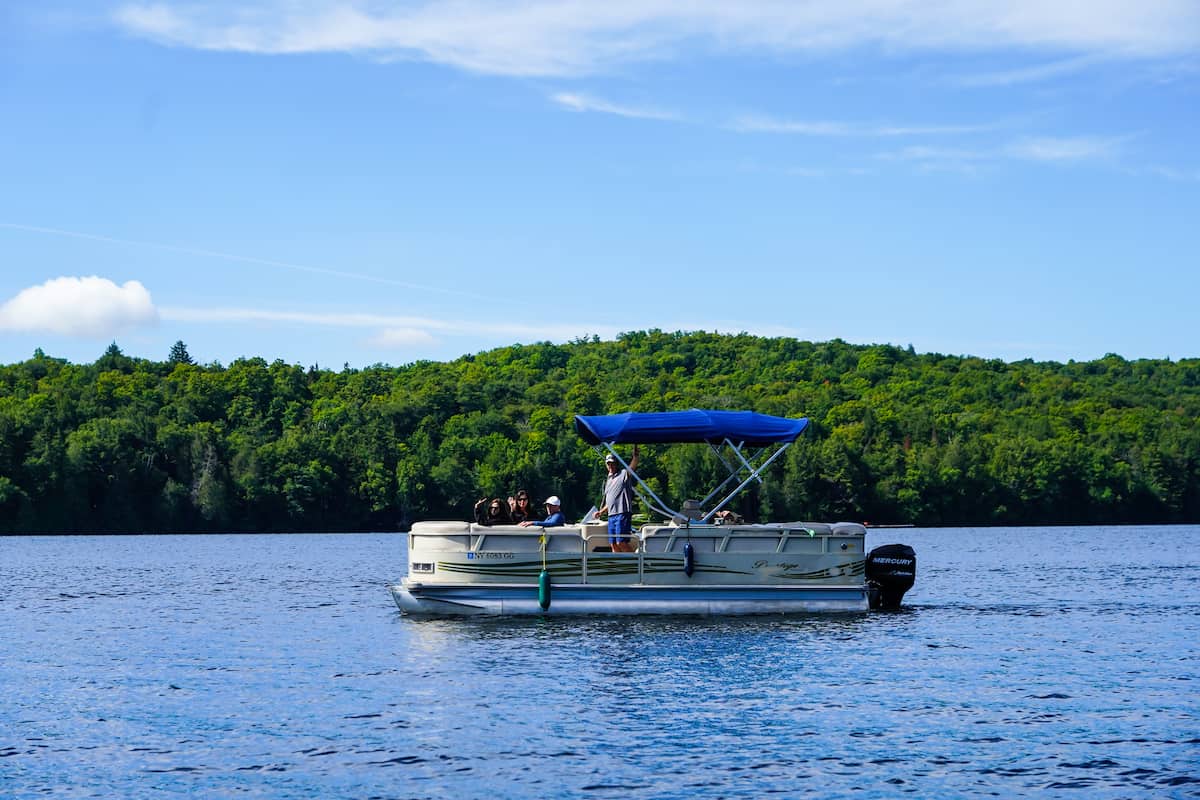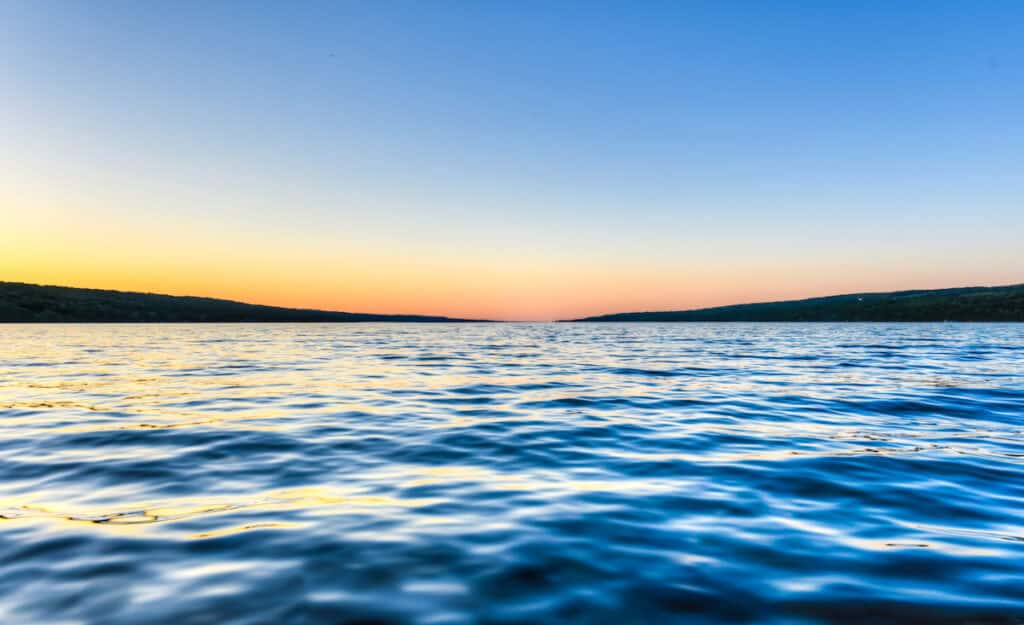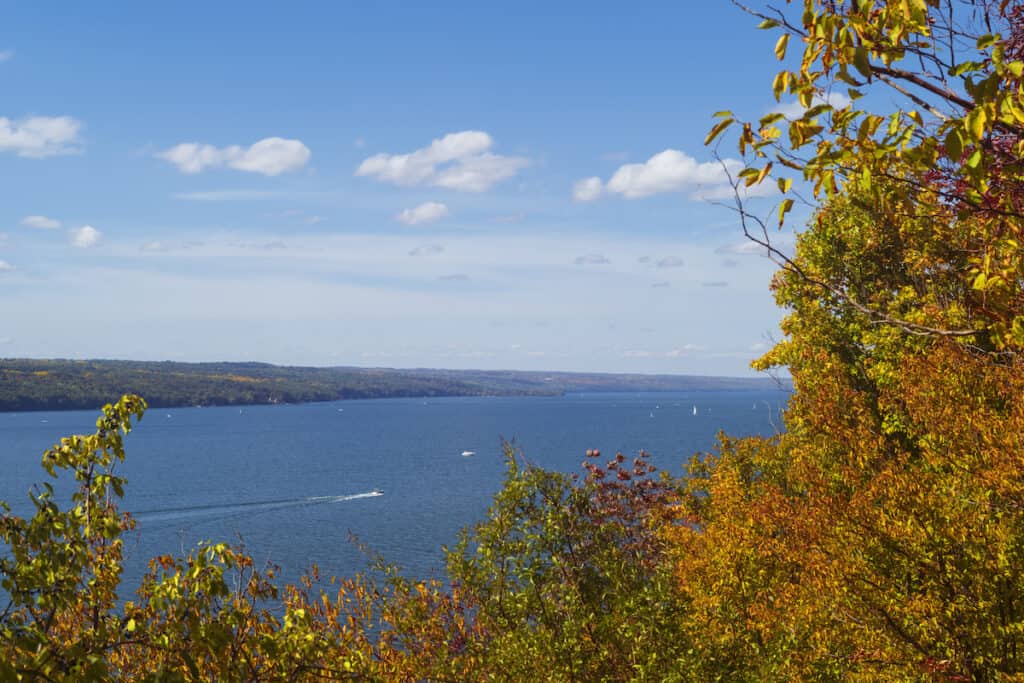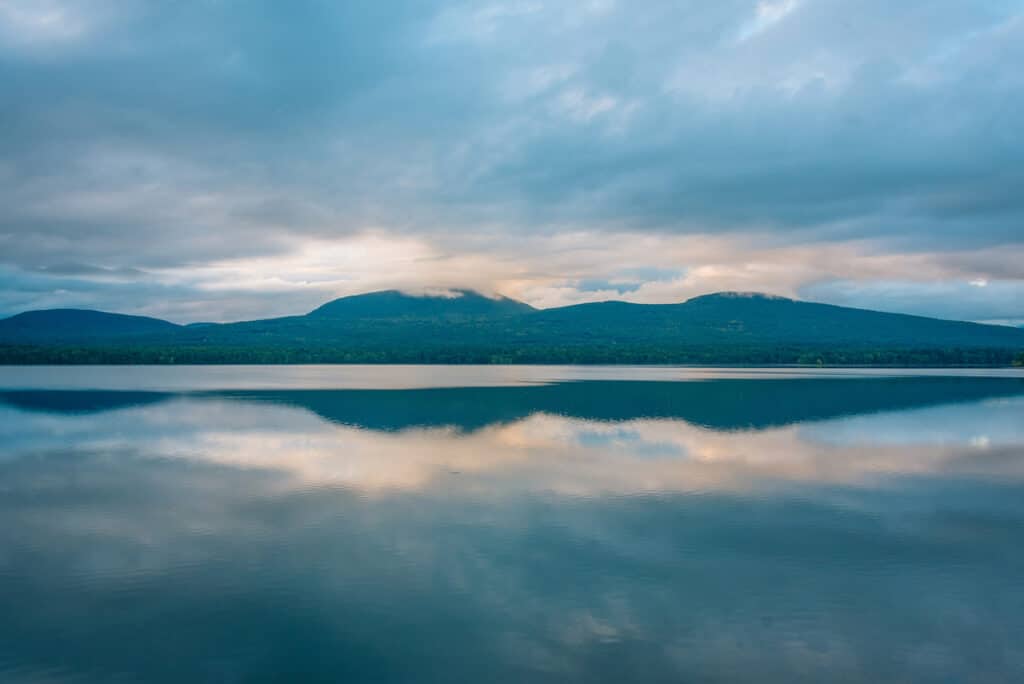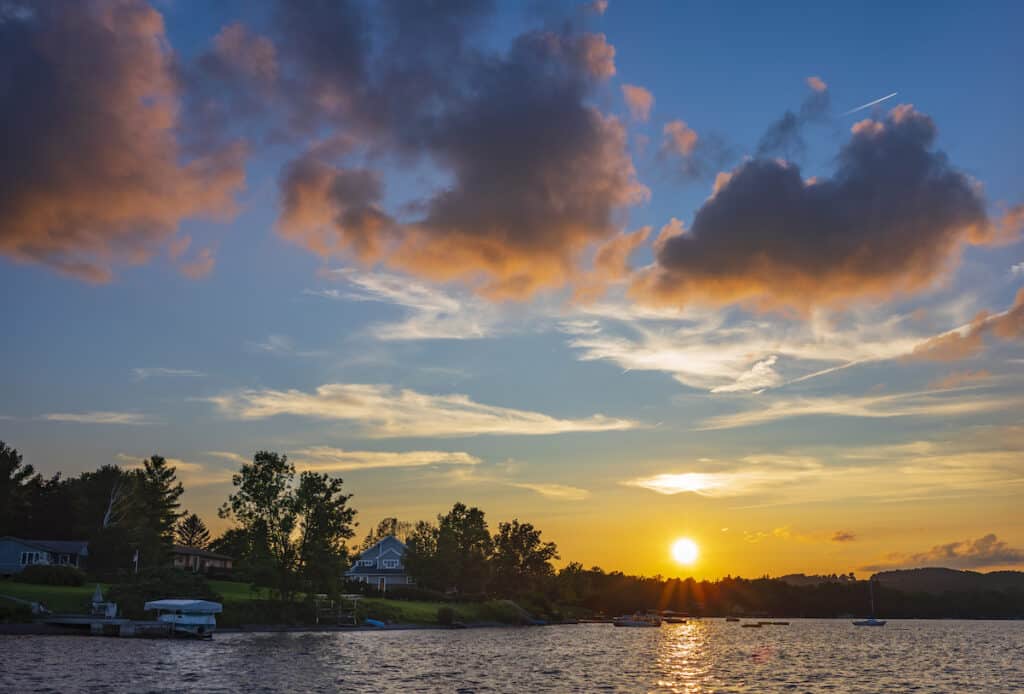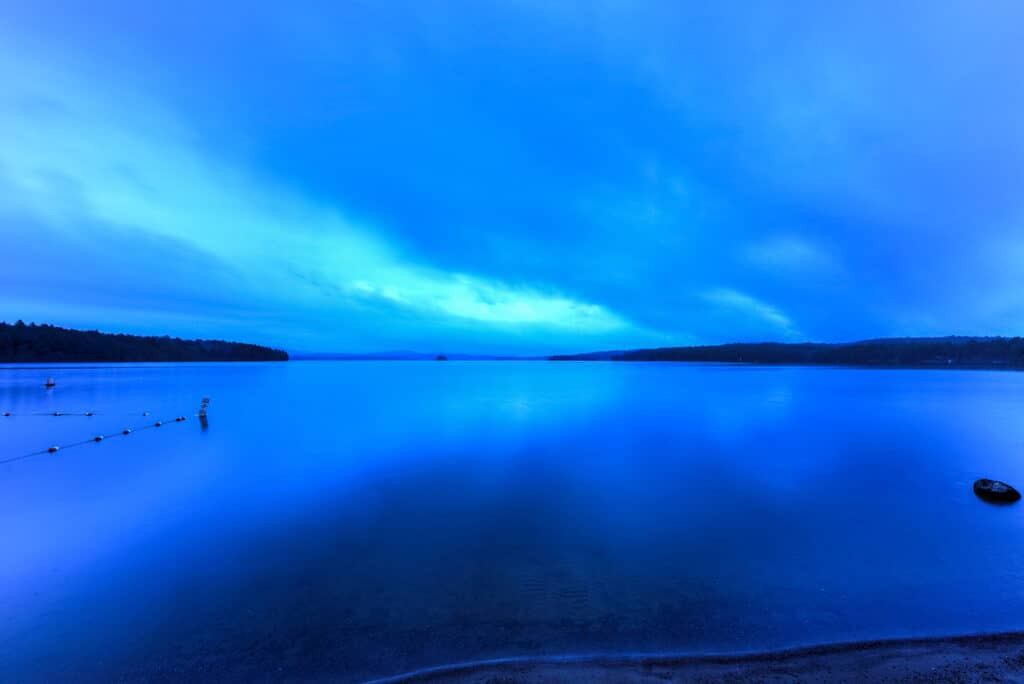Few states offer a greater variety of trout fishing options than New York. Without even taking the state’s many miles of prime trout streams and rivers into consideration, anglers have seemingly endless opportunities to catch these fish.
Monster brown trout prowl the Great Lakes.
Rainbow trout have been stocked heavily in the Finger Lakes and elsewhere.
Deep, cold natural lakes across the state harbor hefty lake trout.
Wild brook trout inhabit hundreds of Adirondack lakes and ponds, some of them no bigger than a few acres.
Editor’s note: Do you also like fishing for trout in moving water? After you check out the lakes below, make sure to also see which rivers and creeks made our list of Best Trout Fishing Streams in New York. There’s lots of great fly fishing information in that article as well.
Top 5 Trout Fishing Lakes
Suffice to say, the best trout lakes in New York span a wide range of species and environments. The tactics you might employ to catch these fish are equally varied.
As a general rule, the best times to go trout fishing in New York are spring and fall. During these seasons, even bank fishermen have a shot at trophy trout, which are most active in moderately cool conditions.
Many anglers also troll deep water for elusive trout in summer, or drop lines through the ice in the dead of winter.
Trout populations in most of these lakes are maintained, at least in part, through regular stocking by the New York Department of Environmental Conservation (DEC). Even so, wild trout populations are not hard to come by.
While your options to catch these species of fish are almost endless, we’ve curated the following list of the very best trout fishing lakes in New York.
Lake Ontario
No lake in New York more consistently produces giant brown trout than Lake Ontario.
The DEC stocks more than 400,000 yearling browns in this Great Lake every spring, many of which survive 5 years or more and end up weighing well over 10 pounds.
New York’s state record brown trout, a true monster at 33 pound, 2 ounces, was caught from the Oswego County portion of Lake Ontario in 1997.
Spring is prime time for big Lake Ontario browns. The optimal temperature that these fish prefer is right around 58 degrees, and in springtime, they’ll head toward shallow water seeking comfortable temperatures and schools of baitfish.
This can happen as early as March.
Many anglers troll for brown trout this time of year along the lake’s many miles of open shoreline. They often deploy minnow-imitating stickbaits and plugs, either flat-lined or with planer boards. Chartreuse and firetiger patterns work well, as do blue/silver combos.
No boat? There are amazing shore fishing options for trout in the early season.
New York’s Lake Ontario shoreline has a lot of fishing piers and breakwalls that are great for early spring trout fishing. The pier in Fair Haven Beach State Park, at the mouth of Little Sodus Bay, is a prime spot.
Some of the best areas are around the mouths of creeks and rivers, where the more turbid water attracts schools of baitfish, and makes brown trout less wary than they are in the lake’s usually-clear waters.
As the water warms up in late spring, trout move deeper, and anglers catch them trolling small spoons on downriggers.
By summer, Lake Ontario stratifies, and brown trout will hover right above the thermocline. Look for places where the thermocline meets bottom structure.
Brown trout make an epic spawning run in September and October.
This time of year, there’s incredible fishing in Lake Ontario’s tributaries, and anglers often catch a mix of brown trout and salmon in rivers including the Oswego and the Genesee, as well as Oak Orchard Creek.
Maybe obviously, Lake Ontario also made our list focusing strictly on the best brown trout fishing in New York.
St. Regis Canoe Area
Located in the Adirondack Mountains, the St. Regis Canoe Area is New York’s only designated Canoe Area. It’s managed as a wilderness, and spans over 18,000 acres with 58 bodies of water within its boundaries.
Those bodies of water range from half-acre unnamed ponds to 388-acre St. Regis Pond, and they collectively represent the best opportunities to New York to catch wild, native brook trout.
Native brook trout have inhabited these glacial ponds for thousands of years, and pursuing them here almost feels like fishing in a different era.
Only non-powered craft are permitted in the St. Regis Canoe area, and many ponds are far from the nearest road, only reachable on foot or by boat.
146-acre Long Pond is the most easily accessible pond in the area, and offers great trout fishing despite getting relatively heavy fishing pressure. As a general rule, however, the deeper into the wilderness you go, the better the fishing gets.
Fly fishing with nymphs and streamers is highly effective at times, and dry flies will work when there’s a hatch going. Many anglers use spinners and spoons too. A live worm behind a wobbling spoon is a popular combination.
Focus on shoreline cover in spring and fall when trout are closer to the bank.
In summer, brook trout retreat to deeper water, but are frequently caught at depths around 20 feet. Some of the ponds here are spring-fed, and trout congregate around the cool springs in summer.
Brookies measuring 15 inches and up are common in many ponds in the St. Regis Canoe Area, and some ponds also harbor lake trout and splake.
Primitive backcountry campsites are located along many ponds and trails, and a quality map of the area is essential.
Seneca Lake
Eleven glacially-formed lakes make up the Finger Lakes in Central New York, and nine of them support trout populations. Seneca Lake is widely regarded as the best trout lake of the bunch.
Seneca Lake is also the largest of the Finger Lakes, spanning 43,343 acres. And with depths up to 618 feet, it’s the deepest lake entirely within the state of New York.
Lake trout thrive here, and are sustained through a combination of stocking and natural reproduction.
For most anglers, most of the time, trolling is the way to go. Even by trout standards, lake trout favor waters that are deep and cold.
It’s common for trout fishermen on Seneca Lake to troll at a depth of 45 to 55 feet over 60 to 100 feet of water.
Lake trout prefer temperatures from 46 to 59 degrees, and a common strategy is to try to identify places where the temperature is in the upper 40s right at the bottom.
Small spoons are the lures of choice, including Daredevil and Michigan Stinger spoons. Many local anglers swear by silver Sutton Spools, which are made in Naples, New York.
The National Lake Trout Derby is held on Seneca Lake every year over Memorial Day weekend, and typically gives out around $30,000 in prizes. Fish weighing over 10 pounds are caught every year.
In addition to lake trout, Seneca has also been abundantly stocked with brown trout and landlocked Atlantic salmon. Rainbow trout reproduce naturally.
Spring is the best time to catch all four species of salmonids in this lake, especially for shore anglers.
Every April, anglers who wade and fish from shore have a chance to fill a stringer with trout in the Watkins Glen area, which is at the south end of the lake. Some of the best spots include the Watkins Glen Pier and the stretch of bank access along Salt Point Road.
Sampson State Park also has a great fishing pier and is an excellent place to camp and launch a boat. Lodi Point State Park is another potential launch site that provides access to some of the deepest water near the midpoint of Seneca Lake.
Besides trout, Seneca Lake also has robust warm water fisheries, including some of the best northern pike fishing in New York.
More: Complete Guide to Seneca Lake Fishing
Cayuga Lake
Another one of the Finger Lakes, 42,956-acre Cayuga Lake is second in size only to Seneca Lake. We could argue all day about which one offers better trout fishing. In truth, the answer probably changes from one year to the next.
Every year, Cayuga is stocked with somewhere around 60,000 lake trout and 25,000 brown trout. A further 50,000 rainbow trout are stocked in its tributaries.
Depths in the 70- to 90-foot range are productive in summer, and anglers either troll with downriggers or jig over deep structure. Jigging spoons and bucktail jigs are effective, and the latter are often tipped with a live baitfish.
Historically, trout in Cayuga Lake have spent much of their time following schools of alewives and smelt around open water. Increasingly, round gobies are also on the menu.
Round gobies are an invasive species of small, bottom-dwelling fish that swept through the Great Lakes in the late ‘90s, and have since turned up in some of the Finger Lakes as well.
They have become a major prey species in Cayuga Lake, and continue to change fish behavior patterns in ways that are not yet fully understood. Lake trout in particular seem to key in on gobies.
In early spring, lakers and big brown trout are often shallow enough that anglers can catch them from the bank at Taughannock Falls State Park. Try a nightcrawler on a slip sinker rig, or live minnow beneath a slip float.
Focusing on the mouths of tributaries is always a good strategy in spring and fall. While lake trout spawn in the lake itself, the largest rainbows and browns will stage in areas off tributaries like Salmon Creek, Fall Creek and Taughannock Creek.
If you tire of chasing trout, Cayuga Lake’s shallows also produce some of the best largemouth bass fishing in New York.
More: Complete Guide to Cayuga Lake Fishing
Ashokan Reservoir
A 8,315-acre impoundment in the Catskills, Ashokan Reservoir is fed by Esopus Creek and is part of a system of waterways used for New York City’s water supply. The water here is deep, clear and cold, supporting healthy trout populations.
The lake consists of two separate basins separated by a weir.
The East (Lower) Basin and West (Upper) Basin are each stocked with 9,000 to 10,000 brown trout every fall. Fall also happens to be the best season for brown trout fishing and the best catches usually come from September to October.
Browns weighing 10 pounds are caught here every year. Trolling with plugs, spoons and live bait is usually the best tactic, but it’s possible to catch these fish from shore in fall.
Alewives, referred to locally as sawbellies, are a major forage species in Ashokan Reservoir and make excellent trout bait. Trolling slowly with alewives at 25 to 35 feet is popular, sometimes with a flasher or dodger for added attraction.
Wild rainbow trout also inhabit Ashokan Reservoir, and they spawn every spring in Esopus Creek, which flows into the West Basin. The area of the West Basin known as Chimney Hole is reliably productive for rainbow trout.
Shore fishing is also available from the Ashokan Reservoir Promenade, which hugs a 2.8-mile stretch of the lakeshore. There are points along the promenade where the deep part of the original river channel is within casting distance of the bank.
Some huge rainbow trout are caught from shore in late winter and early spring. Another tactic is to fish around the weir that divides the two basins, where there’s a significant current.
Honorable Mentions
Countless lakes across the state of New York support wild trout populations, and many more are stocked annually by the DEC, operating as put-and-take fisheries.
Although the lakes mentioned above represent the best of the best, these honorable mentions are also excellent options.
Lake Placid
Lake Placid is better known for skiing than it is for fishing, but the actual lake that gives Lake Placid Village its name is an outstanding trout fishery.
The lake spans 2,173 acres and offers 150-foot depths that are more than capable of sustaining trout year-round.
The DEC stocks around 8,500 rainbow trout in Lake Placid every spring, and lake trout have been self-sustaining in the lake for a long time. A former state record laker weighing 32 pounds was caught here in the ‘80s.
The lake is dominated by two large islands, which give the entire body of water a figure-8-like shape. The deepest water is up at the top of the lake, between Moose Island and Mainland Point. You can count on catching trout here in summer.
During spring and fall, you have more options.
Fly fishing for rainbow trout close to shore can be productive when an insect hatch is happening, especially in spring. Several caddis and mayfly species hatch here, including some major hatches of Blue Winged Olive.
A few brook trout are also caught in areas around Lake Placid’s inlet streams including Falls Brook.
This is a fun lake to fish from a kayak. The DEC maintains a public boat launch near the south end of the lake, and there’s shore access at the dam.
Skaneateles Lake
Another standout trout lake in the Finger Lakes, Skaneateles Lake—it’s pronounced “skinny-atlas”—encompasses 8,960 acres. That places it right around the middle of the pack in terms of size compared to the other Finger Lakes.
The lake trout fishery is notable because it’s entirely self-sustaining. Lakers are not stocked in Skaneateles Lake, but they are nevertheless more abundant here than just about anywhere else in the region.
They tend to be smaller, though. Typical lake trout in Skaneateles Lake run 16 to 18 inches, with only the occasional trophy size fish. Deep jigging in spring and fall are the favorite methods for catching them.
Skaneateles also offers some of the best rainbow trout fishing in the Finger lakes. The DEC stocks about 20,000 ‘bows here every year, and they can be caught by trolling close to the surface in spring and fall.
Shore anglers have a shot at 20-plus-inch rainbows too, especially in October and November.
There’s a lakefront park in the village of Skaneateles with great bank access, and the offering of choice is a worm/marshmallow rig, which uses a mini-marshmallow to float a worm just off bottom.
Skaneateles Lake also rates an honorable mention for best smallmouth bass fishing in a state loaded with bronzeback hot spots.
Cranberry Lake
Located in New York’s North Country among the foothills of the Adirondacks, 6,995-acres Cranberry Lake is a modest-sized natural lake that is managed specifically for brook trout. The DEC stocks around 20,000 brook trout every year.
Despite being only 38 feet deep, Cranberry Lake stays cool and well oxygenated, and lots of holdover trout survive multiple seasons. Brookies weighing 4 pounds are a real possibility.
Spring is the best time to catch them, especially during the evening hours. Brook trout congregate around Cranberry Lake’s various creek inlets at this time of year, and bite readily in shallow water.
A Clear Lake Wobbler or similar wobbling spoon with a live worm on a trailing hook is the most popular setup, though plenty of trout fall for Mepps spinners too. Small streamers are usually the best choice for fly fishing.
The state operates Cranberry Lake Campground on the shore of the lake, which includes bank access and a boat launch.
One of the best shore fishing areas is right around the lake outlet into the Oswegatchie River.
Brown trout have also been stocked, and some big ones are brought to the bank in fall.
Lake Champlain
Although it’s not technically one of the Great Lakes, Lake Champlain is often referred to as the “Sixth Great Lake.” That has as much to do with its massive size as with the fact that it is, in fact, linked by water to the other Great Lakes.
Lake Champlain is a vast natural lake that straddles the Vermont border, encompassing 314,000 acres. It’s one of the best fisheries in either state for both warm and cold-water game fish.
This lake has long been a haven for wild lake trout.
Its water remains chilly well into May, giving anglers more opportunities to catch lake trout from shore than one would typically expect. The best lake trout water is generally in the 35-mile stretch from Westport to Plattsburgh.
Lake Champlain is more of a numbers lake than a trophy fishery, but there are plenty of hard-fighting lakers measuring 18 to 20 inches. Smelt are the primary forage, and the most productive lures are long, narrow silver spoons.
As is so often the case, lake trout head deeper when the water warms in summer, and are caught by trolling with downriggers and lead-core lines.
Lake Champlain usually stratifies between June and September, and lake trout will be found near the thermocline.
Find Lake Champlain in our Vermont coverage of the best trout fishing spots.
More: Complete Guide to Lake Champlain Fishing
Owasco Lake
Here’s one more spot in the Finger Lakes to give a shot! Spanning 6,665 acres and up to 177 feet deep, Owasco Lake is intermediate among the Finger Lakes in both size and depth. It also offers a variety of trout fishing options.
Lake trout, rainbow trout and brown trout are all stocked annually in Owasco Lake, and some of the best fishing is during fall from October into November. Look for big brown trout around Dutch Hollow Brook and Owasco Inlet this time of year.
The stretch along the western shore between Buck Point and Post Point has some very productive water for lake trout in 50- to 100-foot depths. Little Cleos and similar spoons are popular.
Many local anglers also jig for lake trout through the ice in January and February.
Shore fishing and boat launch facilities are available in Emerson Park, at the north end of the lake in the city of Auburn.
Allen Lake
A tiny lake that covers just 58 acres in Western New York’s Allegany County, Allen Lake is a hidden gem for spring trout fishing. This small lake receives some of the most generous plants in the region, especially considering the lake’s small size.
Yearling brook trout and two-year-old brown trout are stocked every spring, and surplus broodstock is often released in Allen Lake in the fall. In recent years, yearling rainbow trout have also been stocked in spring.
These hatchery-raised fish bite readily on trout dough baits like PowerBait Power Nuggets. Salted minnows and live worms are popular as well, and larger trout often fall prey to Rooster Tail spinners and Kastmaster spoons.
Limited holdover does occur, but Allen Lake is, for the most part, a put-and-take fishery. It’s open to trout fishing year-round, and some local anglers ice fish for trout in winter.
The season really kicks off in April, which is when the first stocking usually takes place.
There is a primitive boat launch, ideal for small craft (only electric motors are allowed), but most anglers fish along the earthen dike that forms the lake’s southern shore.

